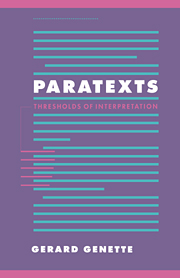Book contents
- Frontmatter
- Contents
- Foreword
- List of books by Gérard Genette
- Translator's note
- 1 Introduction
- 2 The publisher's peritext
- 3 The name of the author
- 4 Titles
- 5 The please-insert
- 6 Dedications and inscriptions
- 7 Epigraphs
- 8 The prefatorial situation of communication
- 9 The functions of the original preface
- 10 Other prefaces, other functions
- 11 Intertitles
- 12 Notes
- 13 The public epitext
- 14 The private epitext
- 15 Conclusion
- Additional references
- Index
1 - Introduction
Published online by Cambridge University Press: 04 November 2009
- Frontmatter
- Contents
- Foreword
- List of books by Gérard Genette
- Translator's note
- 1 Introduction
- 2 The publisher's peritext
- 3 The name of the author
- 4 Titles
- 5 The please-insert
- 6 Dedications and inscriptions
- 7 Epigraphs
- 8 The prefatorial situation of communication
- 9 The functions of the original preface
- 10 Other prefaces, other functions
- 11 Intertitles
- 12 Notes
- 13 The public epitext
- 14 The private epitext
- 15 Conclusion
- Additional references
- Index
Summary
A literary work consists, entirely or essentially, of a text, defined (very minimally) as a more or less long sequence of verbal statements that are more or less endowed with significance. But this text is rarely presented in an unadorned state, unreinforced and unaccompanied by a certain number of verbal or other productions, such as an author's name, a title, a preface, illustrations. And although we do not always know whether these productions are to be regarded as belonging to the text, in any case they surround it and extend it, precisely in order to present it, in the usual sense of this verb but also in the strongest sense: to make present, to ensure the text's presence in the world, its “reception” and consumption in the form (nowadays, at least) of a book. These accompanying productions, which vary in extent and appearance, constitute what I have called elsewhere the work's paratext, in keeping with the sometimes ambiguous meaning of this prefix in French (I mentioned adjectives like “parafiscal” [a “taxe parafiscale” is a special levy] or “paramilitary”). For us, accordingly, the paratext is what enables a text to become a book and to be offered as such to its readers and, more generally, to the public. More than a boundary or a sealed border, the paratext is, rather, a threshold, or – a word Borges used apropos of a preface – a “vestibule” that offers the world at large the possibility of either stepping inside or turning back.
- Type
- Chapter
- Information
- ParatextsThresholds of Interpretation, pp. 1 - 15Publisher: Cambridge University PressPrint publication year: 1997
- 2
- Cited by



